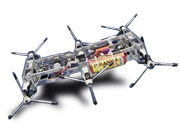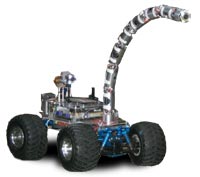| Instructor : 
Jeff Feddersen
email: fed@zaftig.org
url: www.zaftig.org/pcomp
Office Hours:
Tuesdays, 1:30-3:30
Adjunct Office
Course Description:
[ H79.2301.01 ] This course expands the students'
palette for physical interaction design with computational media.
We look away from the limitations of the mouse, keyboard and monitor
interface of today's computers, and start instead at the untapped
expressive capabilities of the human body. We consider uses of
the computer for more than just information retrieval and processing,
and at locations other than the home or the office. The platform
for the class is a microcontroller, a single-chip computer the
size of a postage stamp, programmed using BASIC. The core technical
concepts are digital, analog and serial input and output. Students
have weekly lab exercises to build skills with the microcontroller
and related tools, and three longer assignments in which they
apply the principles from weekly labs in a creative application.
A note about this site vs. the
pcomp homepage
The physical computing syllabus has been standardized so that
the same material is covered in all sections of the course. The
lab assignments and much of the supporting material are the same
across all classes, and our syllabus links into the material maintained
by Tom on the physical computing homepage. However, this site
is specific to our class, and will contain additional
information, so please begin at our
syllabus so as not to miss anything.
Some
Random Photos:
 |
CMUCam: "CMUcam is a new low-cost, low-power
sensor for mobile robots. You can use CMUcam vision system
to do many different kinds of on-board, real-time vision
processing. Because CMUcam uses a serial port, it can
be directly interfaced to other low-power processors such
as PIC chips." |
 |
Brett Hemes' BEAM
Solaroller.
"While traditional approaches essentially start with a "brain," and
attempt to build robots "downward" from that, BEAM
robotics starts from simple reflexes, in a 'bottoms-up' approach.
The majority of BEAM robots are non-computerized (although
simple CPUs can be used to drive them, in a 'horse and
rider' sort of way)." |
 |
Unknown object. Found in a musical
instrument shop in the Ochanomizu district of Tokyo. The
price was ¥62,000 and the tag read "BAKA BAKA". There
is no brand name or any writing on the object; the store clerk
did not know what it was. It had a 1/4" audio output.
|
 |
Snoopy,
a snake robot. "The main challenge in designing snake
robots deals with putting actuated joints in a tight volume
where we minimize the length and cross sectional areas of
the links between the joints. The main concept of our design,
as well as many others, is to stack two degree-of-freedom
joints on top of each other, forming a snake robot. There
are three main schools of designs for these kinds of robots:
actuated universal joints, angular swivel joints and angular
bevel joints." |
 |
NotNot Tickle
Robot. "This small robot walks on the human
body to generate a pleasant, tickling sensation. It has two
motors and rubber feet for a good grip on the skin. When it
encounters a slope that is too steep, it will steer until
a safe level is found, and it will continue its way." |
 |
Kenji Yanobe's Atom
Car. "Visitors are welcome to ride the vehicle,
[Atom Car], which has an on-board Geiger-Muller counter.Three
100 yen cions will activate the vehicle, but it will stop
when the counter detects radiation ten times.Visitors have
to keep dropping coins into its slot to drive(evacuate).All
the proceeds will be used for [Kenji Yanobe Survival Project]." |
|






